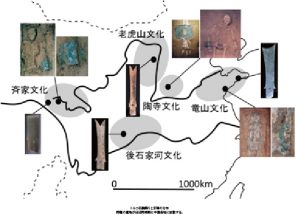A01:Production and Distribution of Prestige Goods
Where were the prestigious goods such as jade, turquoise and cowry shellproduced? How were they exchanged between regions? |

|
| Shinichi NAKAMURA (Kanazawa University) |
In the latter half of the 3rd millennium BC, local civilizations emerged in various areas in China. These include Longshan (Shandong Province), Taosi (Shanxi Province), Shimao (Shaanxi Province), Qijia (Gansu Province), and Houshijiahe (Hubei Province) (the areas in parentheses are the main distribution areas). During this period, artefacts that were distributed over a wide area of China, far beyond the boundaries of local civilizations (archaeological cultures), appeared. Jade, turquoise, crocodile leather drums, cowry shells, lacquer wares, ivory products, mercury vermilion, special potteries such as multicolor painted pottery and white pottery, etc. were all inherited by the Bronze Age civilizations after the Erlitou culture period.
These items were usually placed in burials and are considered to be the property of the social elites. It’s a phenomenon similar to how Rolex watches and Hermès bags are sought after around the world in modern society, regardless of ethnicity, religion, or social system. This phenomenon, in which symbols of authority of the elite class (prestige goods) were shared regardless of differences in archaeological culture, characterizes the cultural and social situation on the eve of the formation of Chinese civilization.
Since these prestige goods appeared in various parts of China at almost the same time, it is quite difficult to tell where the origin of each object was and which direction the diffusion was in. We believe that answering these questions will clarify the role that each local civilization played in the formation of Chinese civilization.
Based on a comprehensive compilation and close observation of the prestigious goods, through grasping their temporal and spatial distribution (chronology), we will try to answer the questions mentioned above. We will also trace the process by which they eventually converged into the Erlitou culture of the early Bronze Age. Furthermore, we will evaluate the probability of the influx of civilization elements from the West into China through archaeological surveys in Central Asia, and proceed with the elucidation of the hybridity in civilization formation from a pan-Eurasian perspective.
Members
| Principal investigator | Shinichi NAKAMURA | Kanazawa University |
|---|---|---|
| Co-investigator | Yumiko MURAKAMI | Kyoto University |
| Shogo KUME | Kanazawa University | |
| Shinji KUBOTA | Kumamoto University | |
| Ryosuke KAKUDO | Komazawa University | |
| Honda Takayuki | Meiji University |

